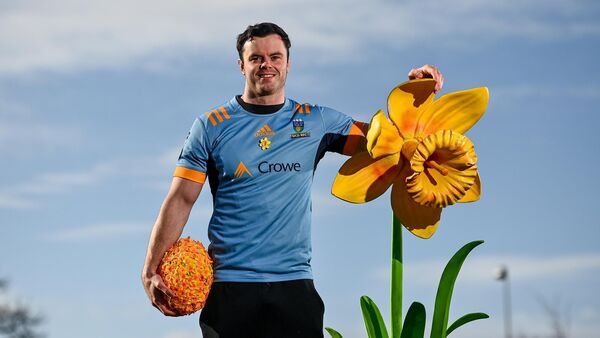I REMEMBER visiting my late grandmother in hospital once when I was around 12 years old. I saw a sign that was stuck on the wall in the nurses’ station that said ‘Smiling is contagious’ and featured a funny looking monkey grinning from ear to ear. That message has stayed with me throughout my life and while I don’t always remember to do it, it’s something I remind myself of as often as I can. If you smile at someone, you will often get one back. It’s human nature.
The same principle applies to certain things in sport. Certain actions are contagious. The more you see your teammates do them, the more likely you are to do them yourself. If you never see anyone do something a bit out of the ordinary, you’re less likely to try it yourself. The clearest example in rugby is when it comes to moving the ball and in particular, offloading.
When you see your teammates being ambitious in trying to shift the ball before and after contact, it gives you a psychological signal that you have a licence to do the same. It’s okay, because the others are doing it. For most teams, the extent to which they throw the ball around will be dictated by the personnel they have in their ranks or the coach they have at a particular time.
For others, like France or Fiji for example, it’s such a deeply engrained part of their DNA that it’s always there.
In fact, it has been the bane of many a French and Fijian coach’s life over the years. When I first arrived in
Grenoble on a short-term deal as injury cover in 2018, I was joined shortly afterwards by Ropate Rinakama, a Fijian tighthead who was playing for the national side at the time. He explained to me that one of the big problems they were having was staying in their structure for a full 80 minutes.
They would be doing everything to the letter of the game plan for half an hour, then someone would pull something
ridiculous out of the bag and chaos would ensue. Second rows would be trying chips over the top, props would be throwing round-the-back offloads; the game plan would go out the window and they would start playing sevens rugby, all of this being triggered by one moment of magic. That was how contagious it was for the Fijians.
French rugby has suffered from a similar problem over the years. I saw it plenty of times in Grenoble, both in my own team and the teams we lined out against in the Top 14 and ProD2.
French rugby has always been associated with excitement, flair, and attractive attacking rugby. This is great, when it’s done properly. Unfortunately, that’s not always the case.
If you throw on any Top 14 game in the depths of winter, you are likely to see balls being thrown on the deck left, right, and centre as players ignore the miserable conditions and act like they are playing in glorious sunshine and 25 degrees.
Players that don’t have the skillset to attempt the ambitious pass or offload still try to do it, particularly if the toss-it-around fever that is so widespread in France takes hold during a game.
This was reflected in the French national side for many years. In fact, a big weakness of the French approach under previous coaching tickets was a somewhat arrogant belief that the fundamentals didn’t need as much attention because their attack was so unpredictable and lethal, they could carve open the opposition at any moment. It was unpredictable alright, but it was unpredictably bad more often than unpredictably good.
They were clinging on to a philosophy that had served them well in the past but one which was totally unsuitable for the modern game. Like almost every other facet of the French approach, Fabien Galthié has modernised the free-flowing rugby they hold so dear, taking the existing roll-the-dice approach and making it tighter, more sophisticated and more clinical. The instinct is still there, but instead of the wild and frantic execution that had become the norm, it is cool, calm, and deliberate.
There were plenty of examples of this in Saturday’s game against Scotland, the standout being France’s second try in the 13th minute. Alldritt carries off the back of a maul on the left wing. Dupont carries briefly and four seconds later the ball has gone through the hands of Fickou, Danty, Ntamack, and Jalibert to reach Penaud six metres from the opposite touchline. It’s worth watching this try a few times on YouTube to appreciate the speed and accuracy with which the ball was moved across the pitch.
Penaud tries to beat Darcy Graham on the outside and when he realises he’s going to get put into touch, turns and flings the ball back inside to prop Cyril Baille. Baille loses the collision himself but manages to get his hands free and chuck it infield to Moefana who dots it down. Seven passes — including two offloads — in one phase of play to go from touchline to touchline and score. Every French back touched the ball in the process.
There are few sides in the world — even at test level — that can execute a move like that. It’s the very essence of a ‘throw the ball around’ approach, done in the best possible way. The French can pull this off because they know everyone is on the same page. Everyone is expecting the speculative pass, offload or whatever else. The team is full of people happy to do it, so everyone else feels confident to do it as well.
IS the Irish attack in a place where we should expect finishes like that? At the moment, probably not. Someone probably would have taken the contact rather than pass at some point in the same scenario, because it would have been the safer thing to do. It takes a level of adventure that isn’t quite there yet. But things are moving in the right direction.
The thing is, just as Galthié had to reign in the compulsion to keep the ball alive, Andy Farrell and company have had to coax some more ambition to do the same out of the Irish players.
Irish rugby does not have a tradition of throwing the ball around like the French do. Irish success in the professional era has been built on being excellent at the basics, being well organised, aggressive, and disciplined. When you have a coach like Joe Schmidt at the helm for almost seven years, who was known for bringing a biblical wrath down on lads for throwing speculative offloads or passes that didn’t come off, it’s no surprise that a reluctance to do anything risky took hold.
If nobody is willing to throw that high risk/high reward pass or offload because they’re worried about getting it wrong, the contagion I talked about earlier does not get a chance to take place. In the same way, players are more likely to try something if they see their teammates lead by example, they will be less likely to do so if nobody else does.
Thankfully, we are starting to see a more ambitious style of attacking rugby take hold. As I have written previously, this is largely being led from the front, with players like Tadhg Beirne, Caelan Doris, and Jack Conan as comfortable passing before and after contact as they are putting the head down and carrying hard.
Farrell’s selection calls last weekend, particularly those of Michael Lowry and Ryan Baird, showed us that he’s willing to try things and take a more holistic view of the types of player that could play an important role going forward.
If a player can offer something different, he won’t be ruled out if he’s perceived to be too short, light, or anything else. That’s not a given in professional rugby these days. When you combine that with overall trajectory of the Irish attack, Andy Farrell is giving all the right signals that his tenure could be a very fruitful one in the coming years.

